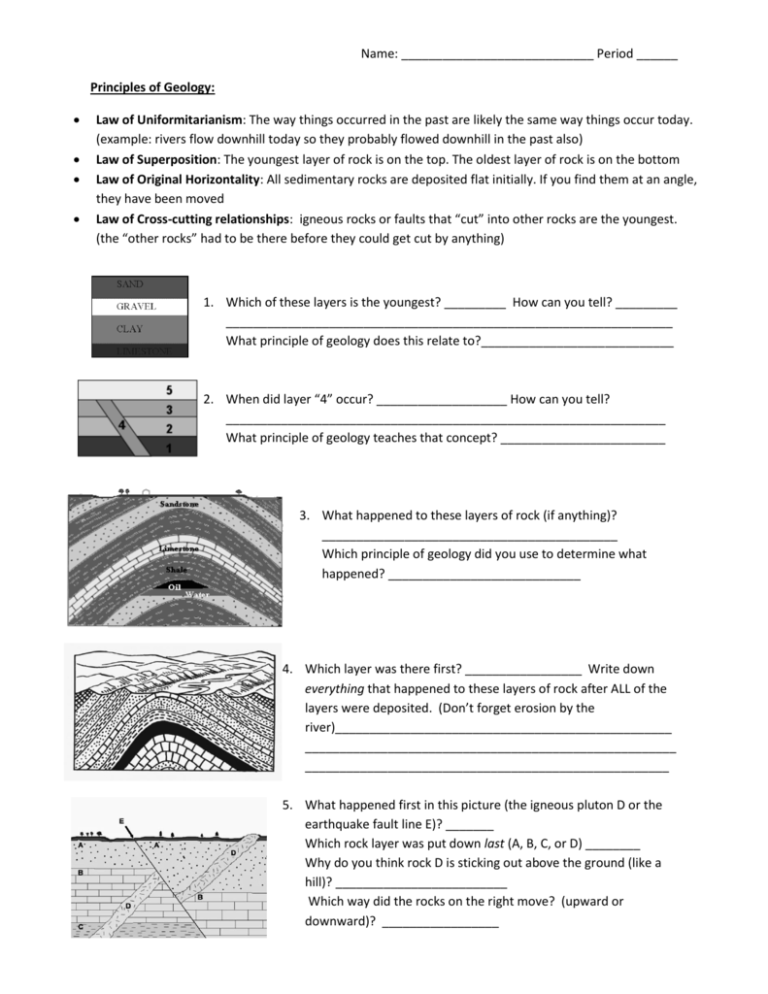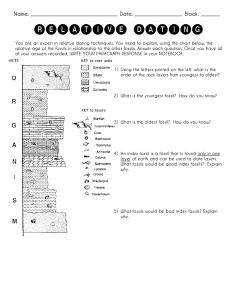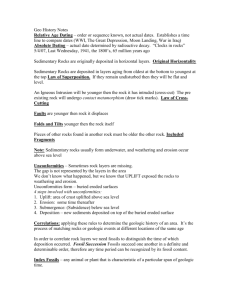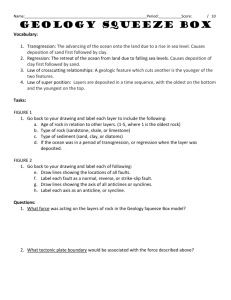Name: Period ______ Principles of Geology: • Law of
advertisement

Name: ____________________________ Period ______ Principles of Geology: Law of Uniformitarianism: The way things occurred in the past are likely the same way things occur today. (example: rivers flow downhill today so they probably flowed downhill in the past also) Law of Superposition: The youngest layer of rock is on the top. The oldest layer of rock is on the bottom Law of Original Horizontality: All sedimentary rocks are deposited flat initially. If you find them at an angle, they have been moved Law of Cross-cutting relationships: igneous rocks or faults that “cut” into other rocks are the youngest. (the “other rocks” had to be there before they could get cut by anything) 1. Which of these layers is the youngest? _________ How can you tell? _________ _________________________________________________________________ What principle of geology does this relate to?____________________________ 2. When did layer “4” occur? ___________________ How can you tell? ________________________________________________________________ What principle of geology teaches that concept? ________________________ 3. What happened to these layers of rock (if anything)? ___________________________________________ Which principle of geology did you use to determine what happened? ____________________________ 4. Which layer was there first? _________________ Write down everything that happened to these layers of rock after ALL of the layers were deposited. (Don’t forget erosion by the river)_________________________________________________ ______________________________________________________ _____________________________________________________ 5. What happened first in this picture (the igneous pluton D or the earthquake fault line E)? _______ Which rock layer was put down last (A, B, C, or D) ________ Why do you think rock D is sticking out above the ground (like a hill)? _________________________ Which way did the rocks on the right move? (upward or downward)? _________________ Name: ____________________________ Period ______ 6. This is a picture of a fault line that is a result of an earthquake causing the land to break and slip. The one on the right side, slipped downward. Which happened first? (The lighter layer outlined by dashes or the fault line)? _______________ Which principle of geology helps you figure that out? ___________________________________ 7. Which happened first (the Coal layer, the Banana Sandstone, or the erosion of Deadman’s canyon)? _______________________________________ What happened to the top of the curvy rocks beneath the Banana Sandstone? ____________________________ Why are the rocks on the bottom folded but the top ones are not? What do you think could have caused this? ________________________________________________ _______________________________________________ 8. What do you think caused the layers on the bottom to tilt upward? ______________________________________________________ Why are the layers on top not tilted? ________________________ ______________________________________________________ Which law states that rocks are always deposited flat first? ______________________________________ 9. This rock has a vein of lava rock that squeezed it’s way in through the crack. Which principle of geology would help you to know that the vein of lava rock is the youngest? ________________________________ 10. Which “blob of lava” (pluton) was in this area first (A, B, or C)? _________ What is your evidence? __ __________________________________________ __________________________________________ A B C Name: ____________________________ Period ______ A B 11. Why are these layers of rock not flat anymore? _____________________ ______________________________________________________________ If I found a fossil trilobite in layer A and a fossil squid in layer B, which one is the oldest fossil? ____________________ How can you tell? ___________ _____________________________________________________________







